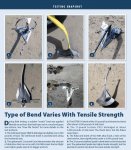Neeves
Well-known member
The title of the graph is SV PANOPE ANCHOR TESTING. Why would he add other testing results from sources that he had no control over?
It is common practice with testing to compare the test results with test results made previously and test results available from other tests made by other people using the same or different protocols. If the 'new' results are different to other results then either the other results are wrong or the new results are wrong. You cannot have a series of test results for a product, in this case a Rocna anchor, that are different by a factor of 2 - without comment or explanation. This is particularly relevant where your test results potentially denigrate the product and to do so, without explanation, is trolling. There might be a good reason the results are at such a variance to everyone else - if which case - say so. If not the results are invalid and should be totally disregarded until such time as an explanation is available.
On the assumption the same protocols are used for all the other anchors - and this what we are led to believe - then if the Rocna results are flawed - then so are all the others.
I simply find it very difficult to accept that Lloyds, RINA, Australian Maritime Safety, West Marine, Voile and others (including members here and the 'general' market place) all got it so wrong, and consistently wrong and the Panope results are the only results of technical excellence.
I also find it interesting that the Mantus M1 seems to be located 4th in the overall excellence. Its hold in the best seabed available, based on a multiplier of 65 for a 15kg anchor is 1,000kg and this result is based on testing in ideal conditions. With a safe factor of 2:1 (not uncommon for anchors) this gives Mantus a 'hold' of 500kg - no yawing. nor horsing from chop - and it is rated 4th!....? And people rave over the Mantus M1. In contrast Spade is rated worse, not by much 5th, vs 4th, yet it has a hold beyond the limits of the equipment as do the 2 Excels. Now - which seabed to most prefer - clean sand or......?
I have said at the outset I am not a fan of Peter Smith, nor CMP but to repetitively denigrate a product which for example, is highly rated in use by most people here, and contradicts every previous test results makes the whole exercise questionable. Furthermore to ignore the difference in the results suggests a contempt for all previous tests (West Marine/Voile et al) and the results produced by the Classification Societies.
Many of the results look robust. The two Excels have a similar ranking. The Mantus M1 hold data in comparison with Delta is not unexpected (its what I have been saying and I have been enjoying the bile of the 'Mantus (M1) Lovers ever since). The poor showing in soft mud for most anchors is what Fortress defined - with the Mantus M1 being the best of a bad bunch. So the protocols look good - with Rocna being an outlier - that demands explanation (or complete removal of the data).
However you cannot remove, in my estimation, the most popular modern anchor from a test programme - without explanation
I do think Rocna is being unfairly hammered - 'why' is the unknown.
Finally - I have questioned the protocols - but also pointed out that most results look robust (its Rocna that is 'wrong' and everything else looks 'right' (except the position in ranking of the M1). The anchors we use, Excel, Viking, Spade all perform well - I cannot comment on the Mantus M2 and the Vulcan never having tested them.
Take care, stay safe
Jonathan

